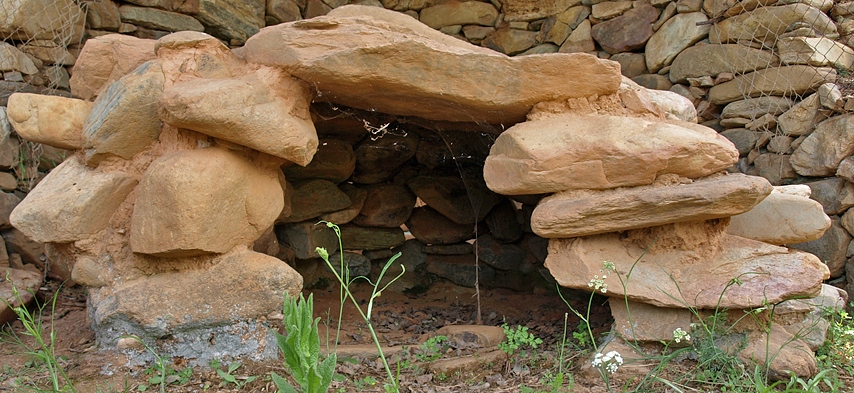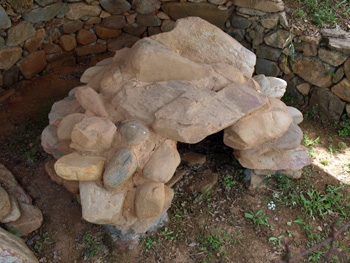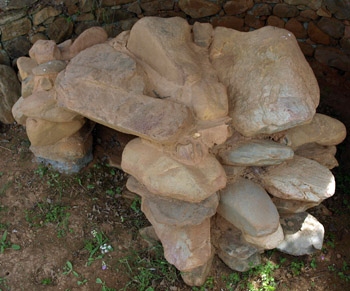Nea Roumata

This Early Minoan I tomb is located just outside the village of Nea Roumata high up in the mountains thirty kilometres south of Chania. It was discovered by accident in 1980. It is a small corbelled circular tomb with a diameter of only 1.10 metres and a height of just 0.61 metres. The entrance was closed by a slab, outside of which three more stones had also been used to seal the tomb. The tholos tomb was built with river pebbles and it contained a body in contracted position. The body had been inserted into the tomb from above in the Cycladic style. Apart from the human remains there were two vases for grave goods, a spherical pot and a cylindrical cup. The floor of the tomb was covered with slabs.
The type of burial is close to that at Krasi, near Mallia, both in terms of its construction and its date, but not for the number of bodies. It points for its origins towards the Cyclades and especially to Syros where similar circular structures with a paved floor have been found.
The tombs of Syros belong to the Syros-Keros culture assigned to Early Cycladic II, which corresponds to EM II. However the two vases found in the tomb at Nea Roumata are notably more primitive and can therefore be dated to EM I. Clear indications of the transitional neolithic period in the rendering of the form and the handles tell us that not only must the tomb itself be dated to EM I, but possibly even earlier to the first half of EM I, that is to say at the very boundary beween the Late Neolithic and the Early Minoan. This date is similar to that of the Krasi tomb but considerably earlier than the so-called Cycladic prototypes.
The Nea Roumata tomb reinforces the generally accepted theory of close relations between the islands of the Cyclades and Crete at the end of the neolithic transitional period and the early phases of the Early Minoan period. But what is new is its presence in a mountainous region far from the sea.
Faint traces of a second similar tomb destroyed by the creation of a dirt track, was discovered in 2001-2 at the same height and about 18 metres north of the first one. Only a few stones of the lower part of the wall and the floor were found. Another tholos tomb was excavated in 1985 on the slopes of a hill two kilometres to the north at a place called Tomadalis. It seems that these tombs are associated with small individual habitations on the tops of low hills in this valley as shown by surface surveys.
The year after the discovery of the tomb, archaeologists investigated the surrounding low hills. At Minatoulia the walls of houses were found. These were dated later than the ceramics from the Nea Roumata tomb, to late EM I and principally to EM II. Unfortunately the site had been greatly disturbed by agricultural activity over the years. It was established, however, that there were also remnants of habitation at Mournidia and Mesaria.
About one kilometre southeast of the tomb on the top of a hill is the area known as Mitatoulia. The plateau at the top of the hill is roughly oval shaped. The area has been dug by tractors and olive trees are dotted about. Early Minoan sherds were found at various points. During excavations three trenches were dug. Trench I, roughly in the middle of the plateau, meaured three metres by four metres with a north-south orientation. Apart from three pieces of obsidian, all the sherds were of Early Minoan origin.
Trench two, northwest of trench one and also three metres by four metres had an east-west orientation. A few Early Minoan sherds were found along with 15 obsidian blades and a piece of rock crystal.
Trench three was larger, measuring three metres by six metres, and was located in the northeast area of the plateau, with an east-west orientation. At a small depth, a brittle schist with an uneven surface covered the whole area of the trench. At the eastern end a large conical vessel with thick sides and a diameter of almost one metre at its widest point was found. The tractor had destroyed the upper part. Inside there were at least three semicircular protuberances and the excavator suggested a fourth may have existed on the destroyed part of the vessel. On the outside there was a similar protuberance.
The vessel had been placed in a circular carved area of schist, the bottom of which was paved with unworked stones. On the west and northwest sides it was surrounded by a wall constructed on the schist and built with small unworked stones. Other individual stones, which did not belong to the wall, supported the vessel on the east side. The inside of the vessel did not contain traces of any substance that would have given a clue as to its original use.
In the northwest part of the trench an oval pit in the schist measuring almost one and a half metres from east to west and just over one metre from north to south was uncovered. Inside it there was a concentrated mass of clay which occupied an area of 0.90 by 0.85 of a metre and a height of nearly half a metre.
The pit was surrounded by a wall of unworked stones in one row, the greater part of which was destroyed. The concentration of a large mass of clay inside the pit shows perhaps that this construction was used for the shaping of vessels. The ceramics were from the Early Minoan period. Also found here were two stone pestles, three obsidian blades, two clay spindle whorls and a piece of rock crystal.


